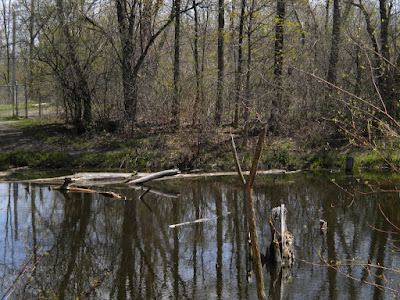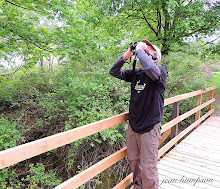With warblers in mind, Jean and I would visit a local ecopark a few times during the month of May. The park contains a mixture of wetland, Savannah grassland and Carolinian forest, with over 170 species of birds seen in the 36 acre city owned property.
May 2
We would start at the north entrance of the park, first hearing then seeing our first Caspian Terns (#115) of 2009 as they flew around the stern of a ship bound for Lock 1 of the Welland Canal. Double-crested Cormorants and Ring-billed Gulls were also following the ship hoping for an easy catch in its wake.
Approaching the pedestrian gate we heard the familiar Oh-sweet-Canada-Canada-Canada of a White-throated Sparrow. We had heard this species the previous weekend during an OFO trip but had yet to observe the bird. In little time, Jean and I spotted the bright white throat and yellow lore of the singing sparrow.
Northern Cardinals were very active, flying back and forth across our path as we walked the trail on the east side of the park. A Carolina Wren was quite vocal and at times making an appearance in the brush.
The first warbler we would come across, and there were many of this species, was a Yellow-rumped Warbler.
An Eastern Towhee (#112) would surprise us emerging from the brush onto the path.
Other warblers viewed during our first visit included, Yellow (#108), Palm (#109), Nashville (#110) and Black-and-white (#113).
Additional birds seen included, Canada Goose, Turkey Vulture, Killdeer, Hairy Woodpecker, Northern Flicker, Blue Jay, Tree Swallow, Black-capped Chickadee, House Wren (#111), Ruby-crowned Kinglet, Blue-gray Gnatcatcher (#114), American Robin, Chipping Sparrow, Red-winged Blackbird, Common Grackle, Baltimore Oriole (#116), American Goldfinch and House Sparrow.
A total of 30 species.
May 8
Jean and I had only been at the ecopark for a few minutes and were enjoying the view of a singing Black-and-white Warbler when Kayo walked in with his friend Brian and asked if we would join them for a morning of birding. With their experience and our younger ears it was sure to be a good day for all.
As we walked along the east trail, we observed Palm, Yellow-rumped and Yellow Warblers. Another birder on his way out informed us all of a Blue-winged Warbler further up the trail. Hey, that was the around the same spot we saw one last year while birding with Kayo, John and Katherine. We would arrive at the spot but could not see or hear the Blue-winged. We cut through a forested section and Kayo flushed a Gray Catbird for Jean and I (#125 for the year list). We would emerge from the forest onto a maintained trail on the west side of the park.
We remained in the forested section of the park and crossed back over towards the pond located on the east side. As we approached the pond, Jean and I heard the "bee-buzz"of a Blue-winged Warbler. Kayo and Brian unfortunately cannot hear this call. It was up to Jean and I to pinpoint the location. The four of us surrounded the area, a "T" intersection of two trails, and our patience would pay off. We spotted a male Blue-winged Warbler (#127).
Additional warblers observed in the park included, Black-throated Green, Nashville and Magnolia (#128). In the same area we spotted these warblers we also found Warbling Vireo (#124) and Blue-headed Vireo (#126).
Other birds not observed previously, Downy Woodpecker, American Crow, Rose-breasted Grosbeak (pair), and Brown-headed Cowbird.
A total of 34 species this day.
May 16
It rained heavily before we arrived for another morning of birding in the ecopark. Jean and I would meet Katherine and her friend as they were leaving. Katherine informed us that they had observed 17 species of warbler, including a beautiful male Cape May. Could we match Katherine's tally? She has an excellent ear for warblers.
Total species this day, 37.
May 23
It would be late in the morning when we started birding our last visit in May. We came across a plant with rather large leaves. No wonder an undetermined species of butterfly laid its eggs here. It couldn't miss.
Warblers were few and far between. Yellow Warblers were in their usual spot on the east side trail. Further searching produced only 1 Magnolia and 1 female Black-throated Blue (we have only seen females of this species so far this year). It was beginning to look like no other warblers would be observed and most likely a Spring without a lifer warbler. It is only our fourth year of birding and we still need to add a few warblers to the life list. Nearing the exit of the park I caught some movement in the weeping branches of a Willow, next to the path that connects the east and west trails. Another Warbling Vireo for the day. But wait. There was another bird. A male Black Poll Warbler, lifer #147.
Only 27 species observed during our last visit but the stunning Blackpoll lifer made up for the disappearance of warbler species.
With Spring migration concluded, it was time to prepare myself for some western birding. As this post spent quite some time stewing as a draft, we already know how the B.C. trip went.
Let's hope the warblers put on a great show in May this year, with perhaps, a lifer amongst them.














No comments:
Post a Comment